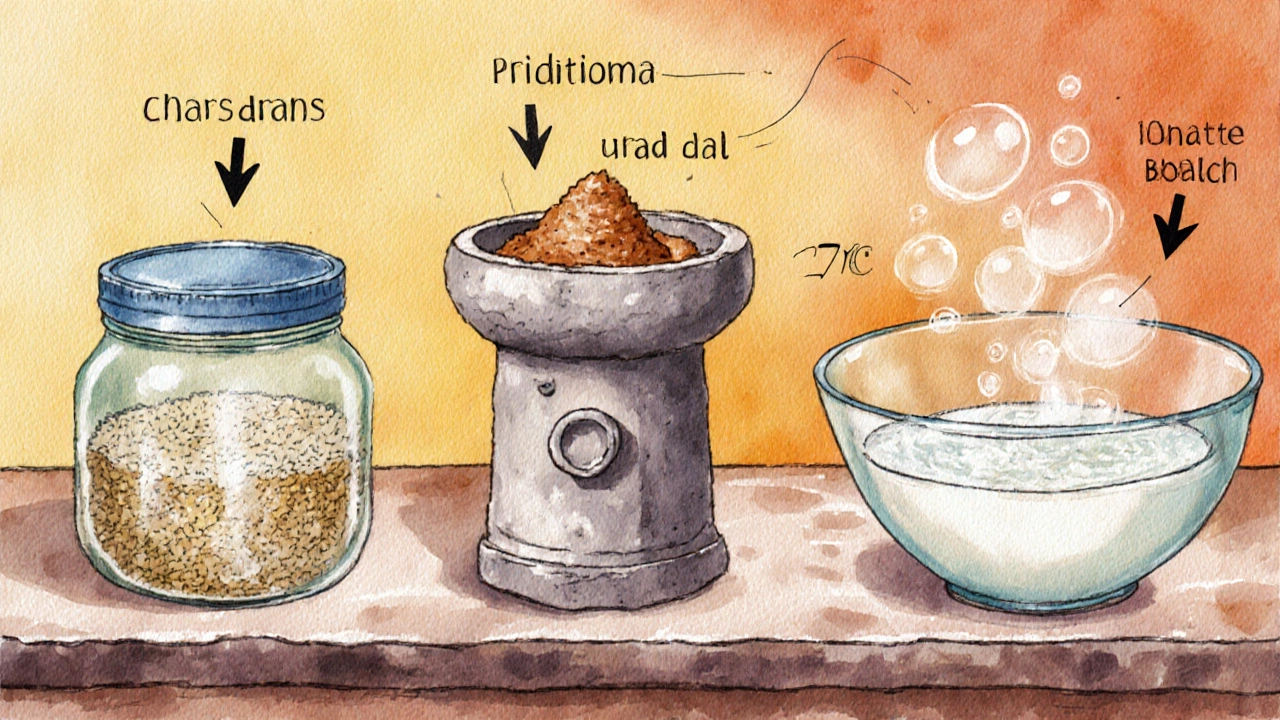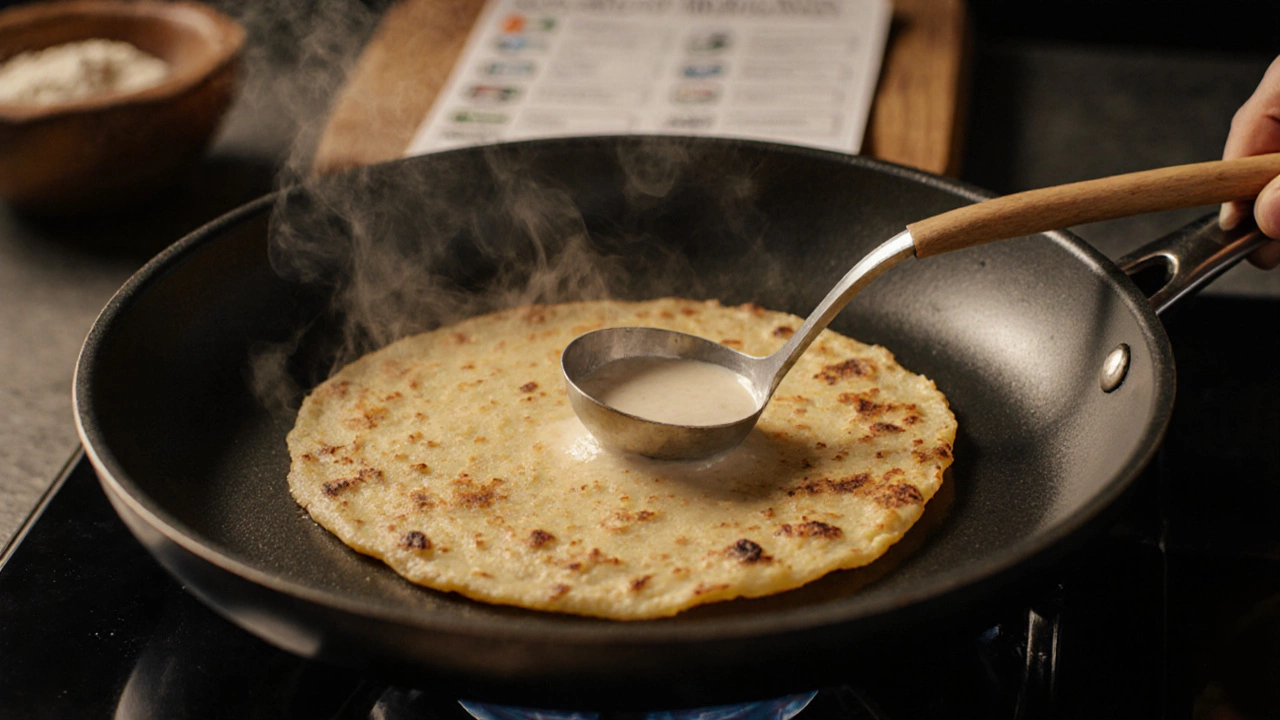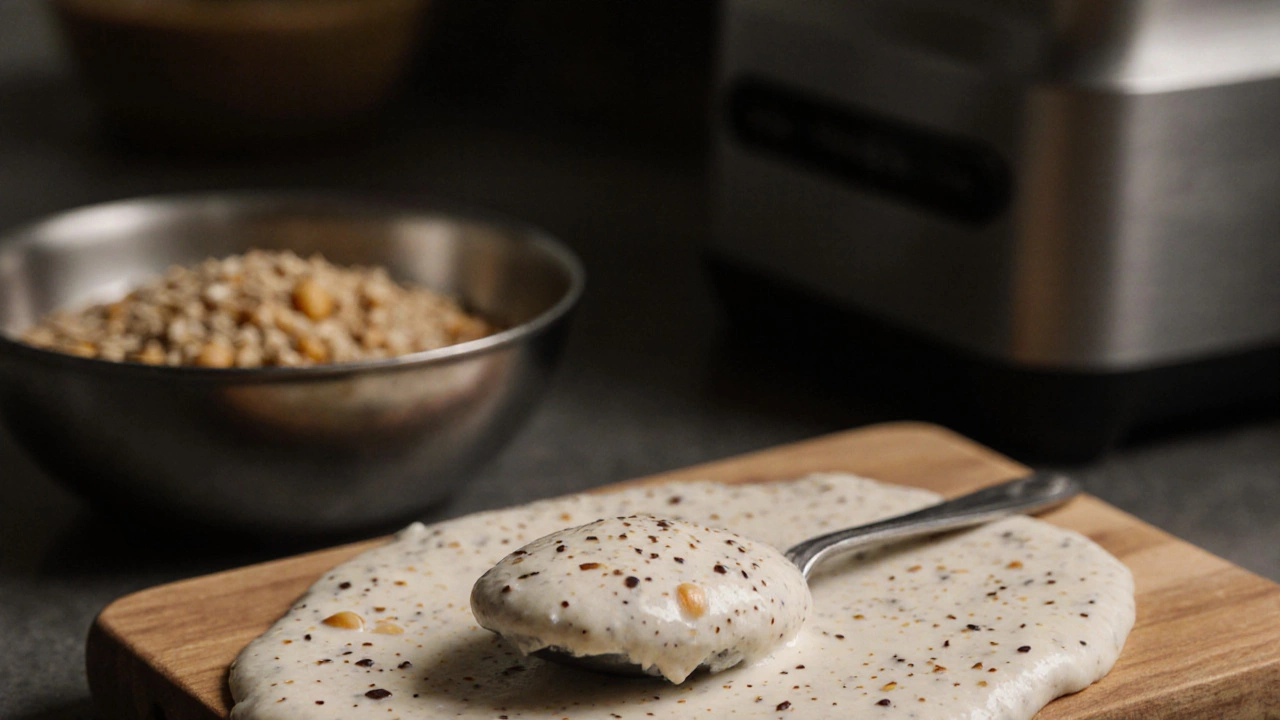When you flick the first spoonful of Dosa batter is a fermented mixture of rice and lentils that forms the base of South Indian crepes, the last thing you want is a gritty, uneven surface on the pan. Yet many home cooks wonder whether a grainy dosa batter signals a mistake or just a harmless variation. The short answer: graininess can be a sign of a few common slip‑ups, but it’s also something you can fix without throwing away the entire batch.
Key Takeaways
- Grainy texture usually comes from improper soaking, insufficient grinding, or incomplete fermentation.
- Using Urad dal is a split black gram that provides protein and helps achieve a smooth batter when well‑ground and Parboiled rice is a partially boiled rice that balances flavor and texture is essential.
- Fermentation time, room temperature, and the type of pan all affect final batter smoothness.
- Simple fixes-extra grinding, gentle blending, and proper resting-can rescue a grainy batch.
What "Texture" Really Means in Dosa Batter
Texture is the tactile quality you feel when you dip a spoon into the batter. In culinary terms, it’s a product of particle size, moisture content, and the degree of fermentation. A good Texture is smooth, slightly thick, and able to spread thinly without clumping. When the batter feels gritty, the particles of rice or dal haven’t been broken down enough, or they’ve re‑aggregated during resting.
Why Graininess Shows Up: Common Causes
Here are the top three reasons a batter ends up grainy.
- Inadequate soaking. Both rice and dal need enough water to soften. If you soak the Urad dal for less than 4 hours, the outer skins stay hard, producing visible specks after grinding.
- Coarse grinding. Traditional stone grinders produce a finer paste than many home blenders. A low‑speed setting or a half‑filled jar leaves larger particles, which show up as grainy bits on the skillet.
- Improper fermentation. Fermentation introduces natural acids that break down starches. A short, cool fermentation (under 20 °C) can leave the batter dense, preventing the particles from fully integrating.
Other minor contributors include using the wrong rice type, adding too much water during blending, or storing the batter in a metal container that reacts with the acids.
Step‑by‑Step: How to Achieve a Smooth Dosa Batter
Follow this checklist to keep graininess at bay.
- Choose the right grains. Use Parboiled rice is ideal because it softens easily while retaining a slight bite, preventing a mushy batter. Avoid plain raw rice unless you pre‑toast it.
- Soak adequately. Soak rice for 6-8 hours and Urad dal is best soaked for 4-5 hours to achieve uniform softness. Use enough water-just enough to cover the grains.
- Grind in stages. First, grind the dal alone with a little water until it’s a thick paste. Then add the soaked rice and water, blending until the mixture feels like a thin pancake batter. Aim for a particle size under 0.5 mm; you can test by rubbing a spoonful between your fingers-no gritty feel.
- Ferment properly. Transfer the blended batter to a clean, non‑metal container. Cover loosely and let it sit at 25‑30 °C for 8-12 hours. In cooler climates (e.g., October 2025 evenings), place the container near a warm oven or a sunny windowsill.
- Rest before cooking. After fermentation, stir gently and let the batter rest for another 30 minutes. This allows trapped bubbles to settle, giving a smoother spread.
- Check consistency. The batter should pour easily but hold its shape when lifted. If it’s too thick, add a spoonful of water; if too runny, add a teaspoon of rice flour.

Tools That Make a Difference
A good Non‑stick skillet is essential for spreading the batter thinly without tearing, which could expose grainy spots or a traditional cast‑iron dosa tawa. The pan’s surface temperature is also critical. Use a Cooking temperature is best kept at medium‑high; a too‑cold pan makes the batter sit and dry, highlighting graininess. Test the heat by sprinkling a few drops of batter; they should sizzle and spread instantly.
Quick Comparison: Grainy vs. Smooth Dosa Batter
| Aspect | Grainy Batter | Smooth Batter |
|---|---|---|
| Particle Size | >0.5 mm, visible specks | <0.5 mm, uniform paste |
| Fermentation | Short or cool, weak acid development | Full 8‑12 h at 25‑30 °C |
| Consistency | Thick, clumpy, hard to spread | Fluid, spreads in seconds |
| Cooking Result | Uneven surface, crunchy bits | Even golden‑brown, crisp |
Common Mistakes and How to Fix Them
Mistake 1: Adding too much water during grinding. Excess water dilutes the natural acids and prevents the batter from thickening. Fix: Drain the soaking water thoroughly and add water drop‑by‑drop while grinding. Aim for a batter that pours like a thin pancake batter.
Mistake 2: Using a low‑speed blender. The blades don’t create enough shear to break down the rice grain. Fix: Pulse at high speed for 2‑3 minutes, then scrape sides and blend again. If the batter is still coarse, run it through a fine mesh sieve.
Mistake 3: Fermenting in a metal container. The acidic batter reacts with metal, altering flavor and texture. Fix: Switch to a glass or food‑grade plastic bowl with a breathable cover.
Mistake 4: Cooking on a cold pan. A cold surface traps moisture, making the batter soggy and showing graininess. Fix: Pre‑heat the skillet for at least 2 minutes, then lightly coat with oil before pouring batter.

Troubleshooting Grainy Batter After Fermentation
If you’ve already fermented the batter and still see grainy spots, try these rescue steps.
- Blend again. Transfer the batter to a high‑speed blender, add a splash of water, and blend for 30 seconds.
- Sift the batter. Use a fine mesh (around 0.2 mm) to remove any remaining specks. The sifted liquid will be smooth; the residue can be mixed back after grinding.
- Adjust acidity. Add a teaspoon of plain yogurt or a pinch of fenugreek seeds, let it sit 15 minutes. The extra lactic acid helps break down stubborn starch clusters.
- Use rice flour. Stir in 2-3 tablespoons of rice flour to bind the batter and mask small grains.
These fixes usually turn a gritty batter into a spreadable, crack‑free mix suitable for classic crispy dosas.
When Graininess Is Acceptable
Not every grainy texture is a deal‑breaker. Some regional variations-like the slightly coarse batter of “Rava Dosa” (semolina‑based) or “Mysore Masala Dosa” with added spice mixtures-intentionally retain a tiny bite. If the grainy particles are less than 1 mm and the flavor is on point, you can still enjoy the dosa. The key is distinguishing between purposeful texture and accidental grit.
Wrap‑Up Checklist
- Soak rice 6‑8 h, urad dal 4‑5 h.
- Grind dal first, then rice, aiming for sub‑0.5 mm particles.
- Ferment 8‑12 h at 25‑30 °C in a glass bowl.
- Rest 30 min before cooking; check consistency.
- Use a hot non‑stick skillet; spread batter thinly.
- If grainy, re‑blend, sift, or add a touch of rice flour.
Why does my dosa batter have sand‑like particles?
Sand‑like particles usually mean the urad dal or rice wasn’t soaked long enough or the grinder didn’t run on high speed. Soak both ingredients fully and blend until the mixture feels like a fine paste.
Can I use regular white rice instead of parboiled rice?
You can, but regular white rice tends to produce a softer, sometimes mushy batter. Parboiled rice gives a firmer bite and helps keep the batter from turning grainy.
My batter ferments quickly and still feels gritty. What’s wrong?
Fast fermentation can happen in warm climates, but grit persists if the grinding was coarse. Re‑blend the batter and sift it to remove larger particles before cooking.
Is it okay to store fermented batter in the refrigerator?
Yes. After the initial 8‑12 hour fermentation at room temperature, refrigerate the batter. It will keep for 3‑4 days. Bring it to room temperature and stir before using; you may need a splash of water to restore consistency.
How do I know when the batter is perfectly fermented?
A perfectly fermented batter has a pleasant sour aroma, tiny bubbles on the surface, and a slightly airy texture when lifted with a spoon. It should feel thick but pour easily.
